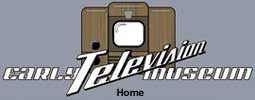
|
Vintage Television Sets and Colour Television Sets from the Dawn of Television until Now
Echard Etzold's Site |
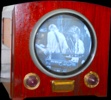
|
Vintage Television:
Raytheon Porthole M1101
1949
Click photos for enlargement!
|
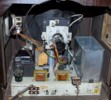
|
The Raytheon M-1101 is an American TV set manufactured in Raytheon’s Belmont Radio plant in Chicago on October 1949, the peculiarity of this set is the image, which has a round shape, employing the whole screen area (unlike most of the other sets, where the CRT face was more or less masked to give a rectangular appearance), this style of TV is known as "porthole", like the "windows" on a ship. The CRT (type 12LP4) is a 12" diameter and having a relatively low deflection angle, about 60°, it’s very long, so the cabinet has to be quite deep, in order to contain it. The TV set was made to work on 110V/60Hz, 525 lines video signal, with a maximum consumption of around 220 Watts; the set has a 12 channels tuner (from Ch-2 to Ch-13) with a hidden fine tuning control screw. Front panel has all main image control knobs, while on the back panel focus and other coarse controls are found. This TV set came from Canada to Italy, where it was restored, on late spring 2007. Giulio did all the restoration works on the circuit as following described, while Angelo helped in finding original spares and worked on the restoration of the other parts of the set and on the final assembly.
|
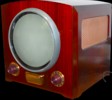
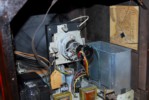
Made in Raytheon’s Belmont Radio plant in Chicago (Illinois) the tv set was probably originally sold in 1949 in Detroit (Michigan) due to a worn label still visible on the masonite back cover, and then transferred some way from USA to Canada, during the past 60 years, ending in Bridgewater (Nova Scotia), and then finally shipped by Air-Canada Cargo and Lufthansa Cargo to Italy packed into a robust wood crate, thanks to the great efforts of Angelo’s cousins John and Shelly from Nova Scotia.The M-1101 circuit is quite classic, even for us European, but a few particular things are important to note, one of which is the use of a 12AU7 tube as a video output, with the contrast control wired in the cathode circuit of the double triode.
|
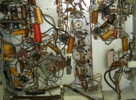
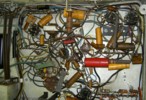
Beside the great work Giulio has done on the main core of this TV set other works were carried on the rest of the set by Angelo, here follows a brief description. The set was completely dismantled leaving a naked chassis and an empty wood cabinet; the cabinet had some major chips and scratches. The chassis was carefully cleaned with mild soap, with a spray ammonia based glass cleaner and, in some particularly dirty area, using gasoline; the chassis was originally protected by a pale green primer coat that, with time passing, suffered in some areas some light oxidation from the lower metal. So far after deep cleaning it was decided not to proceed to repaint it and the whole chassis was left "as is" in still exceptional good condition.
|
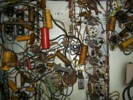
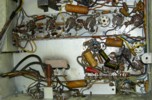
From the first photos, it is evident that this chassis has never been fixed in it’s life, all the components are still the original ones, except a handful of tubes, a normal thing. During the restoration, Giulio tried to maintain as much as possible the originality of the chassis, hiding the new capacitors inside the shell of the old ones, this is quite simple to do, except for the moulded ones, in this case you have to carefully cut and split them open, extract the old guts and, once the new one is in, reseal the shell. Same thing is of course possible with the electrolytics, here the space is usually not a problem, as the old ones are usually quite a bit larger than the new ones, in the same fashion the "canned" filter capacitors located just under the CRT neck were restuffed. For the resistors, the hiding work is not so simple, so the changed ones had to be left "as is", unless some so called NOS resistors were available.
|
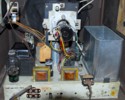

The missing EHT cage was reconstructed with exact dimensions taken from the pictures showed on the original available PHOTOFACTS schematics of this model, the cage is made with thin zinc plated steel foil that was bent and tin welded to fit into the still existing bottom receptacle.
The cabinet walls are made of thick mahogany plywood originally hand rubbed; they have been completely cleaned and paint removed using a soft chemical paint remover with the help of extra-fine steel wool deleting all the scratches also, then the few chips on the lower part were fixed using similar thin mahogany plies adapted and glued on place. The whole cabinet was then treated with tinted wood primer and then hand rubbed with several laying of alcohol based lacquer as on the original. The round 6" loudspeaker had paper cone and core winding completely wrecked (probably damaged when the set was prepared for shipping), so a new cone and core were made and reinstalled by a local skilled artisan, the peculiarity of the original core is the 3.5 ohms impedance, the replaced one is a more usual 4ohms though with unnoticeable consequences. At last the different reconditioned parts of the "good old Telly" were carefully reassembled to complete the reborn old porthole once owned by Angelo’s relatives in Nova Scotia, Canada.
|
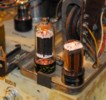
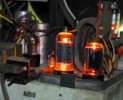
The horizontal output section uses a 6BQ6GT (output tube) and a 6W4GT (damper tube), in conjunction with a 1X2B (EHT rectifier) to produce the 11kV needed for the final anode of the 12LP4. The flyback transformer is not the common autotransformer with various taps to connect the damper diode cathode and the horizontal deflection coils, but it is a true transformer with a separate primary and secondary windings. This arrangement was used only on early TV sets and is not very common in Europe (at least, the author remembers only 1 TV set with this arrangement). The EHT cage, needed to limit the RF irradiation produced in the horizontal output section, was missing, so Angelo did rebuilt it.
|
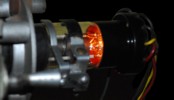
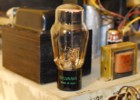
Another particular thing is the CRT requires a double ion trap, one part (the one nearer the tube socket) has a stronger magnetic field, the other part has a weaker field and its purpose is to pull back in the right direction the electrons affected by the stronger part of the ion trap. The restoration went smooth, but 2 big encountered problems have to be mentioned: the first was the power transformer, basically shot, Giulio pulled the 5U4 rectifier to test it, fed it with 110Vac (well, it’s 50Hz here in Italy vs. the 60Hz in America), but the transformer reached over 60°C after few minutes of operation with a light load, basically only the tubes filaments. Lowering the input voltage from 110V to something like 100V did nothing, the transformer only took longer time to reach the over 60° temperature. Knowing this is not normal for a power transformer (and thinking at the further temperature rise with the full load applied), it was disassembled from the chassis and the end bells taken away. The paper insulating the various windings was not the typical light brown, rather a dark brown/black colour, meaning the transformer has overheated. Unwinding it, it was clear why: most of the enamel on the magnet wire was gone, leaving the bare copper touching. Well, time for a rewinding job, Giulio fortunately knows how to do it himself (with lots of patience, by hands, without any help from a winding machine). He had to rebuild the bobbin with a new sheet of Paxolin, as the old one was so toasted to crumble in his hands, in the same time he calculated the transformer for a 230V / 50Hz operation with a bigger iron core. The rewound transformer now reaches around 35/40°C after 1 hour of operation, and with full load applied, not bad as a result!!
The other problem mentioned had to do with the vertical scanning circuit, the TV uses a section of a 6SN7 as a vertical oscillator, and the other half as a vertical output stage. Lowering the scan frequency from 60Hz to the 50Hz, obtained changing a value of a capacitor in the vertical oscillator, resulted in insufficient amplitude, even with the height control maxed! This problem was solved using a 6BX7GT tube in place of the 6SN7, now the raster and the image are at full height, and also the linearity is at least acceptable. As far as the author knows, the vertical linearity was never too good on porthole sets, even when new.
|
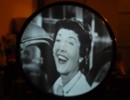

The rejuvenated Raytheon is now used and enjoyed at Angelo’s home; the 625 lines video signal’s coming from an external satellite tuner then converted into Channel 3 or 4 and sent to the tv set by a flat wire thru a balun impedance matching transformer (300/75 ohms).
Below the screen and behind the two main knobs are nice liberty-style gold-shining ornamental plates and covers (knobs bases and control knobs central cover) apparently made in brass that during polishing came out to be a more sophisticated (for that time) golden plated sort of zama-like alloy, a touch of luxury that well matched the mahogany wood. The volume knob was missing but thanks to Tim, a friend from USA, an original knob was found and put in place! On this set a 12LP4A is used (the "A" indicates a green tinted glass screen), the CRT in use has a label that gives the probable date of fit as spare on October 1951, the emission of the CRT, even if it still gives good bright images, has a low 15-20% grade and sooner a better one will have to be installed (if one will be found!) ... and that’s all folks! ... Happy Televisioning J!
02/04/2008, Giulio Maiocco and Angelo Rostagnotto
|
Schematics
Download .pdf-file.
Tubes / Valves:
6AG5, 6J6, 5x 6AU6, 6T8, 6K6GT, 6SL7GT, 6SN7GT, 6BX7GT (originally 1x6SN7GT), 2x 6AL5, 6BQ6GT, 6W4GT, 1X2B, 12AU7, 5U4G, 12LP4. All tubes used on the set are new SYLVANIA made valves, most of them were found NOS-NIB originally made in late 40’s and early 50’s.
Photos: © Angelo Rostagnotto, 2007.
Links:
 Zur Zur
![[German text]](Images/flag_de.jpg)
![[Zurück]](Images/arr-supr.jpg)
Stand: 3. April 2008,
|
